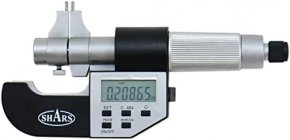So instead of buying a whole set or small sets of gauge pins. Could one just get say .003 below caliber for the desired caliber. Get some factory fodder pull the bullets turn the necks in .005 intervals. Reseat the bullets fire them. Full length size them and then use a pin gauge on the sized brass?
Once you have a case that has a slight interference fit would that not be the proper neck sizer OD? I just looked at the price for a pin gauge set and I’d be better off just getting a bushing bump die.
Also gauging the brass lessens the chance of damaging your dies.
Jon
Canuckenstein, Yes you can certainly get where you want to go without gages or inspection equipment. It really comes down to each of us to decide on how much we invest in tools that may or may not get used for general purposes at home, so I don’t blame you for not wanting to get gage pins if they will collect dust. (See if any of your friends already have a set they can loan you?)
After the responses, I think you can get the main points about FL die dimensions.
Most FL size dies overwork brass and may induce runout when the expander ball comes back through. The hybrid solution where the die diameter is honed and minimized usually produces the longest case life and lowest runout. There are also benefits from exploring the alternative methods for expansion using mandrels or ball sets that come in fine increments.
You would probably be better off with a bushing die if you don’t mind the investment. Neck turning also starts with brass at the correct diameter for a pilot mandrel in order to produce good results, so even there you would need to control the sizing. This is another argument for sizing controls with mandrels.
Neck turning brass may help brass runout in instances where the brass is of low quality to begin with. The relationship of the FL die dimensions and the chamber of sporter rifles can sometimes set up situations where this combination further works the brass over the long term, but only testing can answer if turning is any benefit in a sporter context. My guess is that outcome would be based on your brass and how many different batches and brands of brass you are running.
(Edit to add: you would also be ahead doing runout tests to know the threshold of when it even makes a difference. That means collecting the worst and best for a side-by-side test to see how much you get away with before you can even see it on paper.)
Many of us have been at this game for a lifetime and since a young age. As a result, we have many overlapping tools and methods to manage brass and neck tension. We often have to use our imagination to picture starting out late in life or from a standing start without the benefit of all the collected tools and mentoring.
My last guess is you will end up with all three capabilities on your bench, honed FL dies with more than one expander, a bushing die with a span of bushings, as well as neck turning equipment to satisfy your curiosity. But I will also guess you have more to gain from the first two and buying better brass so you can skip neck turning.













